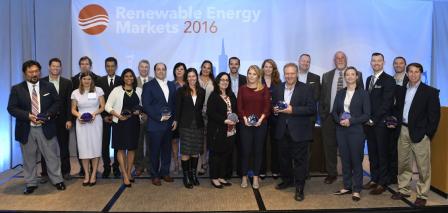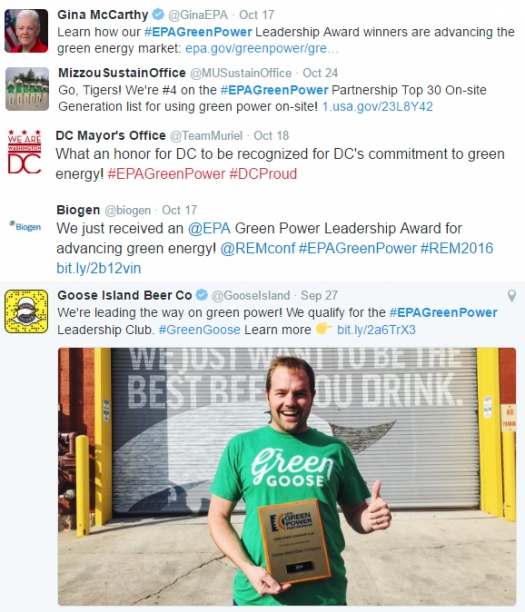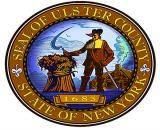Green Power Partnership Program Updates Issue 44
Issue 44, October 31, 2016
- GPP Announces 2016 Green Power Leadership Award Winners
- Highlights from the 2016 Renewable Energy Markets Conference
- EPA Releases Updated Top Partner Lists
- EPA Launches 2016-17 College & University Challenge
- Proposed Revisions to the Green Power Partnership Program Requirements
- In the News—Recent Press on the Green Power Partnership
- On Twitter? Use #EPAGreenPower in Your Tweets
- Partner Spotlight: Ulster County, New York
- Upcoming GPP Webinar—Solar Carports: Turning University Parking Facilities into Renewable Electricity Plants
GPP Announces 2016 Green Power Leadership Award Winners
Congratulations to this year's Green Power Leadership Award winners! On October 17, the Green Power Partnership (GPP) recognized 16 award winners at the 16th annual Green Power Leadership Awards Ceremony, which took place at the Renewable Energy Markets Conference in San Francisco, California. These organizations are leading the way to help significantly advance the development of the green power market.
"Green power is becoming more affordable and mainstream because of leaders like the Green Power Leadership Award winners," said Janet McCabe, acting assistant administrator for EPA's Office of Air and Radiation. "I commend the work they do to grow the renewable energy market and spur innovation, and as we continue to act on climate, I encourage them to continue to set a high bar for others to achieve."
This year's Green Power Leadership Award winners are:
- Excellence in Green Power Use: Biogen, Inc.; BNY Mellon; Forest County Potawatomi Community, WI; Goldman Sachs; Government of the District of Columbia (Washington, DC); Intel Corporation; SC Johnson
- Direct Project Engagement: General Motors / GM Orion Assembly Plant; Google Inc.; HARBEC, Inc.
- Green Power Community of the Year: Maplewood Community, MO
- Green Power Partner of the Year: Cisco Systems; Jackson Family Wines; University at Buffalo, the State University of New York
- Sustained Excellence in Green Power: Apple Inc.; Kohl's Department Stores

2016 Green Power Leadership Award Winners
Learn more about what EPA's 2016 Green Power Leadership Award winners are doing to advance the green power market. EPA and the Center for Resource Solutions (CRS) co-present the awards—read more about the nine CRS Green Power Leadership Award winners. View the EPA press release.
Interested in highlighting your organization's green power achievements and applying for a Green Power Leadership Award in 2017? The application period will open in late winter 2017. Look out for GPP emails announcing the opening of the application period.
Highlights from the 2016 Renewable Energy Markets Conference
The 2016 Renewable Energy Markets Conference was full of excitement, with informative and dynamic presentations and more attendees than ever before. The conference took place October 16-18 in San Francisco, California, and participants from across the U.S. and from around the globe shared ideas on promoting clean energy and how to advance the renewable energy market. Organized by CRS and co-sponsored by the EPA Green Power Partnership, this annual meeting of clean energy stakeholders includes green power providers, utility representatives, purchasers, policymakers, and regional stakeholders, and sets the agenda for the year to come. If you couldn't make it to the conference you may access many of the conference presentations via the REM website (click on a presenter's name to download): http://www.renewableenergymarkets.com/rem2016/.
Next year, REM will be taking a bite out of the Big Apple! Save the Date for REM 2017, October 22–24, 2017 at the New York Hilton Midtown! We hope to see you there. Visit the REM 2017 website to join the email list for up-to-date information.
EPA Releases Updated Top Partner Lists
On October 24, GPP released updates to its Top Partner Rankings, which highlight the leading organizations using green power. Below are a few highlights:
- National Top 100 Partners: Two new Partners debuted on the list this quarter—Digital Realty and Tarrant County College District—ranking 18th and 88th, respectively. The University of Tennessee, Knoxville; H&M; Rackspace US Inc.; the University of Missouri; and the University of Maryland all ratcheted up their green power use and moved up the list.
- Top 30 College and University: The University of Tennessee, Knoxville increased its green power use to 246 million kilowatt-hours (kWh) and took the top spot from the University at Buffalo. The New School, which recently joined GPP, and the University of Wisconsin - Stevens Point, which recently increased its green power use, both appear on the list for the first time, ranking 25th and 26th, respectively.
- Top 30 Tech and Telecom: Digital Realty took the sixth spot on the list, while Rackspace US Inc. and Autodesk both increased green power use and jumped to the ninth and 24th spots, respectively.
To see what else changed on the Top Partner Rankings this quarter, visit www.epa.gov/greenpower/green-power-partnership-top-partner-rankings.
GPP updated Partner engagement statistics for two additional initiatives and will do so again on January 23, 2017. The On-Site Renewables Challenge is an initiative in support of President Obama's Climate Action Plan (PDF) (21 pp, 311K) with a goal to double the use of on-site green power by Green Power Partners by the end of the decade. GPP's Green Power Communities list represents towns, villages, cities, counties, or tribal governments in which the local government, businesses, and residents collectively use green power in amounts that meet or exceed EPA's Green Power Community usage requirements.
EPA Launches 2016-17 College & University Challenge
GPP also launched the 2016-17 College and University Green Power Challenge on October 24, which encourages higher education institutions to increase their use of green power.
There are currently 89 schools from 34 athletic conferences participating in the 2016-17 Challenge. The Big 10, which was the 2015-16 Collective Conference Champion, enters as the top-ranked conference. Together, the Big 10's participating schools use more than 449 million kilowatt-hours (kWh) of green power annually—equal to the electricity use of more than 41,000 average American homes. The University of Tennessee, Knoxville enters this year's Challenge as the top individual school, procuring nearly 246 million kWh of green power annually.
In order for your school to be listed on the first scheduled update on January 23, 2017, you will need to have your institution’s green power usage information reported to EPA no later than January 4, 2017. More on the College & University Green Power Challenge and how to participate: www.epa.gov/greenpower/college-and-university-challenge.
Proposed Revisions to GPP Program Requirements
Since GPP was established, EPA has continually reviewed and updated the Partnership's program requirements. The proposed updates released by email on October 17 are intended to:
- Enhance program credibility by reflecting changes in the green power market;
- Support best practices and leadership in green power use;
- Strengthen program integrity and stakeholder relationships by making changes that are easy to communicate, understand, and implement;
- Increase program cost-effectiveness by simplifying program administration; and,
- Enhance value to Partners that meet the program's minimum usage requirements.
EPA is seeking comments on proposed changes to the program requirements. Please submit comments by Friday, November 18, 2016 to both:
- James Critchfield, EPA Green Power Partnership, Critchfield.James@epa.gov
- Anthony Amato, EPA contractor, Anthony.Amato@erg.com
The proposed changes or clarifications to the program requirements cover the following topics:
- Green Power Leadership Club (GPLC)
- "New" renewables requirement
- Eligible generation dates (currently referred to as "Vintage") requirement
- Arizona Renewable Energy Standard and Tariff (REST) requirement
- Eligible scope of green power use requirement
- Leased space energy use estimation requirement
- Hydropower definition
The current Green Power Partnership Program Requirements are available here. The proposed program updates can be downloaded here.
On Twitter? Use #EPAGreenPower in Your Tweets
Please share with others your green energy achievements and involvement with GPP. Every tweet that includes #EPAGreenPower will show up on the GPP home page's Twitter feed as well as the Twitter page with tweets that contain that hashtag. Take a look!

In the News—Recent Press on the Green Power Partnership
Green Power Partners have received quite a bit of press recently, especially in conjunction with October's Green Power Leadership Awards and Top Partner Rankings updates.
The quotes below highlight what a few of our Partners are saying about being recognized for their green power efforts:
Rackspace US Inc.: On improving its Top Lists rankings:
"This is a wonderful accomplishment and it makes me proud of the commitment Rackspace has made when it comes to renewable energy sources," said Kelly Hurst, the senior manager of environmental sustainability at Rackspace. "2016 will be a milestone year for Rackspace. We will be halfway to our goal of being powered by 100 percent renewable energy. Rackspace finished 2015 with 45 percent renewable energy worldwide and is on track to meet its 2016 goal of 50 percent." (October 24 Press Release)
Jackson Family Wines: On winning an EPA Green Power Partner of the Year Award:
"It is a great honor to be the first winery selected by the EPA as a Green Power Partner of the Year," said Katie Jackson, VP Sustainability and External Affairs. "Our investment in renewable energy is driven by my family's commitment to make the highest quality wines in the most responsible manner...We are excited to be leaders in demonstrating the value of green power in supporting energy independence and reducing greenhouse gas emissions." (October 19 Press Release highlighted by Sustainable Brands)
Maplewood Community, MO: On winning an EPA Green Power Community of the Year Award:
"The Maplewood community is being recognized for their efforts in expanding the domestic renewable energy market. The community's support of green power increased by more than 300 percent, resulting in more than 5 percent of the total community-wide electricity use last year." (October 17 News Story)
Cleveland State University: On becoming a Green Power Partner:
"We are very proud to be recognized by the EPA," said Joseph Han, CSU's Associate Vice President for Administration and Operations. "Using green power helps the university become more sustainable, while also sending a message to others across the U.S. that supporting clean sources of electricity is a sound business decision and an important choice in reducing climate risk." (October 17 Press Release)
GPLA winners were also highlighted in leading trade outlets:
- Environmental Leader: And the Green Power Leadership Award Goes To…
- GreenBiz: Energy Leaders Advance at REM16, EPA Green Power Partner Awards
Partner Spotlight: Ulster County, New York
 County Executive Hein with environmental community leaders.Michael Hein, County Executive of Ulster County, recently answered some questions about the county's green power use.
County Executive Hein with environmental community leaders.Michael Hein, County Executive of Ulster County, recently answered some questions about the county's green power use.
Q. What motivated your local government to use green power?
A. Ulster County has sought ways to substantially reduce the environmental footprint and increase the sustainability of our county government operations through energy conservation, efficiency, and the use of renewable electricity.
Q. Tell us about your organization's green power procurement.
A. Ulster County had historically purchased green power, through the procurement of renewable energy certificates, to cover approximately 10 percent of our average annual usage. In 2014, Ulster County began purchasing renewable energy certificates (RECs) to cover 100 percent of its annual usage. Since then we have exceeded that high standard and currently purchase green power equal to 150 percent of our annual electricity use via a 50 percent green power utility product in addition to our 100 percent unbundled REC purchase. The County is committed to purchase RECs to cover all its electricity consumption through 2017.
We generate a small percentage of electricity through a roof mounted photovoltaic (PV) system. However, we are in process of significantly expanding our on-site generation.
Q. Describe any innovative green power strategies your organization has, or is planning to implement.
A. Ulster County is in the process of constructing a large-scale (2.53MW) off-site solar array for which we will retain the RECs. This will be a power purchase agreement (PPA) and the electricity generated will equal more than 25 percent of the county's use. The array is being installed on a closed former landfill near many of our county offices. We are excited that we will be generating more renewable electricity locally on a site where it will be visible and "real" for many of our residents and visitors.
Q. What do you see as the benefits of using green power and what role does it currently play in your organization's broader business and environmental strategy?
A. Purchasing green power is an integral part of our strategy to be a carbon neutral government operation. It is important to us for the following reasons:
- It is replicable by other municipalities, businesses, and the public. We negotiated with our green power provider to extend the price we pay for RECs to other municipalities within the county.
- REC purchases indirectly support the further deployment of renewable energy across the region and the country.
- Green power purchases create an important educational opportunity, which cultivates community-wide sustainability practices and awareness.
- Finally, by offsetting the purchase cost of RECs through energy efficiency improvements, we demonstrate to the public that fiscally responsible government practices can also be environmentally responsible government practices.
Q. What advice would you give to other organizations interested in using green power, and is there anything you would do differently?
A. Take advantage of the fantastic resources EPA has to offer through the Green Power Partnership and apply for a Green Power Leadership Award. We have found it very effective to highlight our participation in the GPP to better communicate the benefits of the green power we have. Also, we encourage other partners to attend a Renewable Energy Markets conference; my staff found it to be an incredible learning opportunity. (Editor's Note: Ulster County won a 2015 EPA Green Power Purchasing Award).
Q. How do you communicate your green power use to consumers, employees, and other stakeholders?
A. In addition to highlighting our commitment to green power as part of our annual State of the County Message, we have included the purchase of green power as one of the elements of our GREENER BY DESIGN initiative. These initiatives focus on conservation and efficiency as well as the use of electric vehicles and renewable fuels and deployment of large-scale on-site solar. We found that the public responds well to seeing the purchase of RECs as part of a larger, more comprehensive energy campaign.
Q. How has being an EPA Green Power Partner benefited your organization? Why do you think GPP is a good program to join?
A. GPP has helped us to better communicate our accomplishment to the public. We are a smaller sized municipality, but we rank with some very large municipalities on the Top 30 Local Government list. That helps the public better recognize the scale of our accomplishment.
Upcoming GPP Webinar: Solar Carports: Turning University Parking Facilities into Renewable Electricity Plants
Thursday, December 8, 2016
2:00 - 3:00 PM EST
Register today!
Today, there are an estimated 5,300 colleges and universities in the United States, and together, those campus facilities contain millions of parking spaces. This webinar explores how colleges and universities can transform underutilized parking facilities into solar power generation systems. By installing on-site solar, institutions can better control their energy costs, reduce their carbon footprints, meet stated renewable energy goals, and develop real-world teaching tools. In addition, solar carports shade and protect cars from the elements, reduce parking lot temperatures, and are a highly visible reminder of a school's commitment to renewable energy.
The webinar will feature two case studies of universities with solar carport projects.
Michigan State University is outfitting five of its parking lots with solar parking bays for a total of 10 megawatts, which are anticipated to meet five percent of the campus' power needs.
Point Loma Nazarene University is home to 620 kilowatts of solar that spans two rooftops and five solar carports. The university financed its solar carports through a 20-year power purchase agreement.
Speakers:
- Christopher Kent, Program Manager, U.S. EPA's Green Power Partnership
- Lynda Boomer, Director of Planning, Design and Construction, Michigan State University
- Trisha Still, Sustainability Officer, Point Loma Nazarene University




